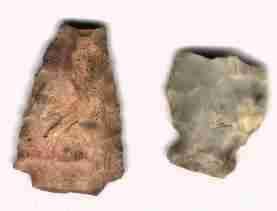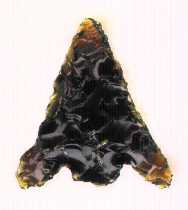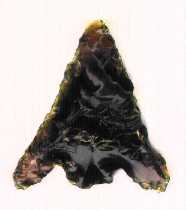 (left) flint
(left) flint
To be able to do anything technological, we need the ability to cut, grind, pierce, and pound various materials. In the beginning, teeth were undoubtedly the first tools to be used for these purposes. It's hard to skin an elephant or carve a statue using your teeth alone, however. Tools made of wood, bone, and stone appeared very early in prehistory, certainly more than a million years ago.
Before discussing the manufacture of stone tools, we need some background on stone itself. Stone is a generic term used to describe any of the naturally occuring solid materials which make up the Earth. The term is generally not used in geology. Instead, geologists use the terms rock and mineral. The distinction between rocks and minerals follows from our discussion of pure substances. The term mineral is used to describe naturally occurring solid materials which are essentially pure (remembering that nothing is 100.00% pure). The term rock is used to describe a naturally occurring mixture of minerals. The mixture may be either homogeneous or heterogeneous. Several features can be used to distinguish pure substances from mixtures:
When discussing rocks, then, we will refer to the minerals present in the rock. When discussing minerals, we will refer to the chemical composition, crystal structure, and melting point.
Our immediate concern is with materials suitable for making tools. Not all stone is suitable for toolmaking. The key requirements for a cutting tool are that it should be sharp and durable. Minerals are not very suitable for toolmaking because of their crystalline structure. When a crystal is broken, it cleaves primarily along certain faces. Such cleavage does not generally produce a sharp edge. So we don't want to use a mineral for toolmaking. Heterogeneous rocks consist of interlocking crystals of different minerals. When broken, such rocks will split between the different crystals, and again a dull edge is produced. A homogeneous rock generally lacks an overt crystalline structure. It can be broken in any direction, not just along crystal faces. There are many homogeneous rocks and they vary considerably in their mechanical properties. For our purposes, we need a hard rock, that is, one that is not easily scratched. Among hard, homogeneous rocks, the silicates are the most abundant (12% of the earth's crust) and were the material of choice for primitive stone tools.
 All silicate rocks are derived from the mineral quartz, with chemical
formula SiO2, also known as silicon dioxide (new name) or silica (old name).
Quartz is very hard, transparent, hexagonal prizmatic crystals. When crushed,
it is a white powder. Any color is due to impurities. Quartz crystals can be
formed either by the slow cooling of molten silicate rocks, or by precipitation
from water that is saturated with dissolved silica. While pure quartz is both
hard and beautiful, its overt crystal structure makes
this mineral less than ideal for making stone tools.
All silicate rocks are derived from the mineral quartz, with chemical
formula SiO2, also known as silicon dioxide (new name) or silica (old name).
Quartz is very hard, transparent, hexagonal prizmatic crystals. When crushed,
it is a white powder. Any color is due to impurities. Quartz crystals can be
formed either by the slow cooling of molten silicate rocks, or by precipitation
from water that is saturated with dissolved silica. While pure quartz is both
hard and beautiful, its overt crystal structure makes
this mineral less than ideal for making stone tools.
 (left) flint
(left) flint
Chalcedony is a broad class of silicate minerals all with approximate formula
SiO2, but with a microcrystalline structure which makes them appear
amorphous or noncrystalline to the naked eye. They are formed by precipitation from
water that is saturated with dissolved silica. They may be brightly colored
due to the presence of impurities. Varieties of chalcedony include agate,
flint, and petrified wood. When struck they produce the characteristic
conchoidal fracture which is fundamental to stone toolmaking technology.

(right) flint tools

(left) quartzite
Quartzite is a metamorphic rock composed primarily of quartz but which may include
significant amounts of other minerals. The purest forms of quartzite appear
similar to quartz but with fractures throughout. Less pure forms may be colored
and the least pure forms may even be heterogeneous with different minerals
embedded in the quartz matrix. When struck, quartzite fractures conchoidally
but these fractures may be interrupted by the fractures initially present in the
rock. Consequently, while it is possible to make stone tools from quartzite,
it is much harder to work than either chalcedony or obsidian.

(right) quartzite tools
 (left) obsidian
(left) obsidian
Obsidian is an igneous silicate rock.
It originates as molten silica with significant amounts of
dissolved impurities. If this molten material were to cool slowly, pure crystals
of quartz might grow from it. But when it cools quickly, the impurities are frozen
in, preventing the growth of crystals. Common impurites include iron oxides
which impart a dark, often black color. When struck, obsidian exhibits the
most easily visible conhcoidal fractures of any silicate. This pattern is clearly
visible on the two smaller flakes in the picture to the left.
Note the rings which are concentric with the point at which the rock was struck.
Obsidian is the material most highly prized by both ancient and modern makers
of stone tools.

(right) obsidian knife, by Chris Bryant
Your best resource for learning to make stone tools is the 2 hour video "Caught Knapping" available in the Fuqua Center. Other flintknapping pages are listed below. The conchoidal fracture is the basis for all flintknapping. If you have ever seen the fracture which results when a BB hits a glass window, you have seen the conchoidal fracture. On the side of the glass where the BB struck, there is a small hole on the entrance side which widens into a cone-shaped hole on the exit side.
| |
| |
\ |
\|
exit <--- <------ impact
/|
/ |
| |
| |
When a silicate is struck on the edge rather than in the middle, only part of the cone is actually removed resulting an a partially conical flake. The edge of this flake can be sharper than a razor blade but is is generally not very strong. When making stone tools, our goal is to produce an edge which is both sharp and strong. To accomplish this, we start with a large flake and then remove smaller flakes, first from one side, then from the other. This results in a tool which is lens-shaped with an edge which is serrated like a steak knife. Such an edge is both sharp and strong. It is this edge which distinguishes an intentionally crafted tool from a broken rock.
Another difference between a stone tool and a broken rock is that all but the most primitive tools are lensatic in cross section. Such a shape can be produced by pressure flaking on the serrated edge. Detailed descriptions of the pressure flaking process are given in Tim Rast's excellent page From Beer Bottle to Arrowhead.
Believe it or not, you will produce some extremely sharp flakes in the course of this project. Consequently, you will need protection for both your hands and your eyes. You will need a pair of glasses, either prescription glasses, sunglasses, or safety glasses. It would be very foolish to work without such protection! In addition, you may want to use a pair of work gloves when breaking your bottle.
The stone tool quiz consist of three questions on any of the following topics discussed in this page.
You have two major sources of information to draw upon in making stone tools: The video tape Caught Knapping on reserve in the the library, and the very extensive Flint Knappers Anonymous web pages, particularly the section From Beer Bottle to Arrowhead.
Using flint, quartzite, obsidian, or bottle glass, make yourself an arrowhead or knife. You have quite a bit of latitiude in the design of your tool. You may choose to haft it to a wooden handle or shaft if you wish. There are only a few restrictions:
 You are free to make your own knapping tools for this project. Alternately, a tool
kit is available which consists of a notching tool,
(left), 60d nail (center), pressure flaker (right), and palm pad.
You can check out a kit for a $5 deposit, returnable when you return the kit.
BYOB.
You are free to make your own knapping tools for this project. Alternately, a tool
kit is available which consists of a notching tool,
(left), 60d nail (center), pressure flaker (right), and palm pad.
You can check out a kit for a $5 deposit, returnable when you return the kit.
BYOB.

 Here are both sides of my first beer bottle point. I made it August 6, 1998
in about 2 hours from the bottom of a bottle of Harp. Click on the images for
a larger view. The actual size is 1 1/8" in length.
Here are both sides of my first beer bottle point. I made it August 6, 1998
in about 2 hours from the bottom of a bottle of Harp. Click on the images for
a larger view. The actual size is 1 1/8" in length.
Each day I will display a collection of rocks and minerals with labels that change from day to day. When you have finished your stone tool, you should request the stone tool quiz which will ask you to identify one of the stones from the collection. In addition, the quiz will ask you two questions about the properties of stone. Bring your completed quiz to me along with your stone tool. It is a violation of the honor code to turn in a tool you did not make yourself.
I will grade your quiz and examine your stone tool. If you miss any of the three questions on the quiz, you fail. If, in my opinion, a paleolithic teenager would be embarrassed to show your tool to his father, you fail. You may, however, try again (once per day) until you pass.